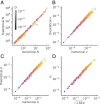Antigenic waves of virus-immune coevolution
- PMID: 34183397
- PMCID: PMC8271616
- DOI: 10.1073/pnas.2103398118
Antigenic waves of virus-immune coevolution
Abstract
The evolution of many microbes and pathogens, including circulating viruses such as seasonal influenza, is driven by immune pressure from the host population. In turn, the immune systems of infected populations get updated, chasing viruses even farther away. Quantitatively understanding how these dynamics result in observed patterns of rapid pathogen and immune adaptation is instrumental to epidemiological and evolutionary forecasting. Here we present a mathematical theory of coevolution between immune systems and viruses in a finite-dimensional antigenic space, which describes the cross-reactivity of viral strains and immune systems primed by previous infections. We show the emergence of an antigenic wave that is pushed forward and canalized by cross-reactivity. We obtain analytical results for shape, speed, and angular diffusion of the wave. In particular, we show that viral-immune coevolution generates an emergent timescale, the persistence time of the wave's direction in antigenic space, which can be much longer than the coalescence time of the viral population. We compare these dynamics to the observed antigenic turnover of influenza strains, and we discuss how the dimensionality of antigenic space impacts the predictability of the evolutionary dynamics. Our results provide a concrete and tractable framework to describe pathogen-host coevolution.
Keywords: coevolution; fitness wave; host–pathogen dynamics; viral evolution.
Conflict of interest statement
The authors declare no competing interest.
Figures




References
-
- Nourmohammad A., Eksin C., Optimal evolutionary control for artificial selection on molecular phenotypes. Phys. Rev. X 11, 011044 (2021).
Publication types
MeSH terms
Substances
LinkOut - more resources
Full Text Sources

